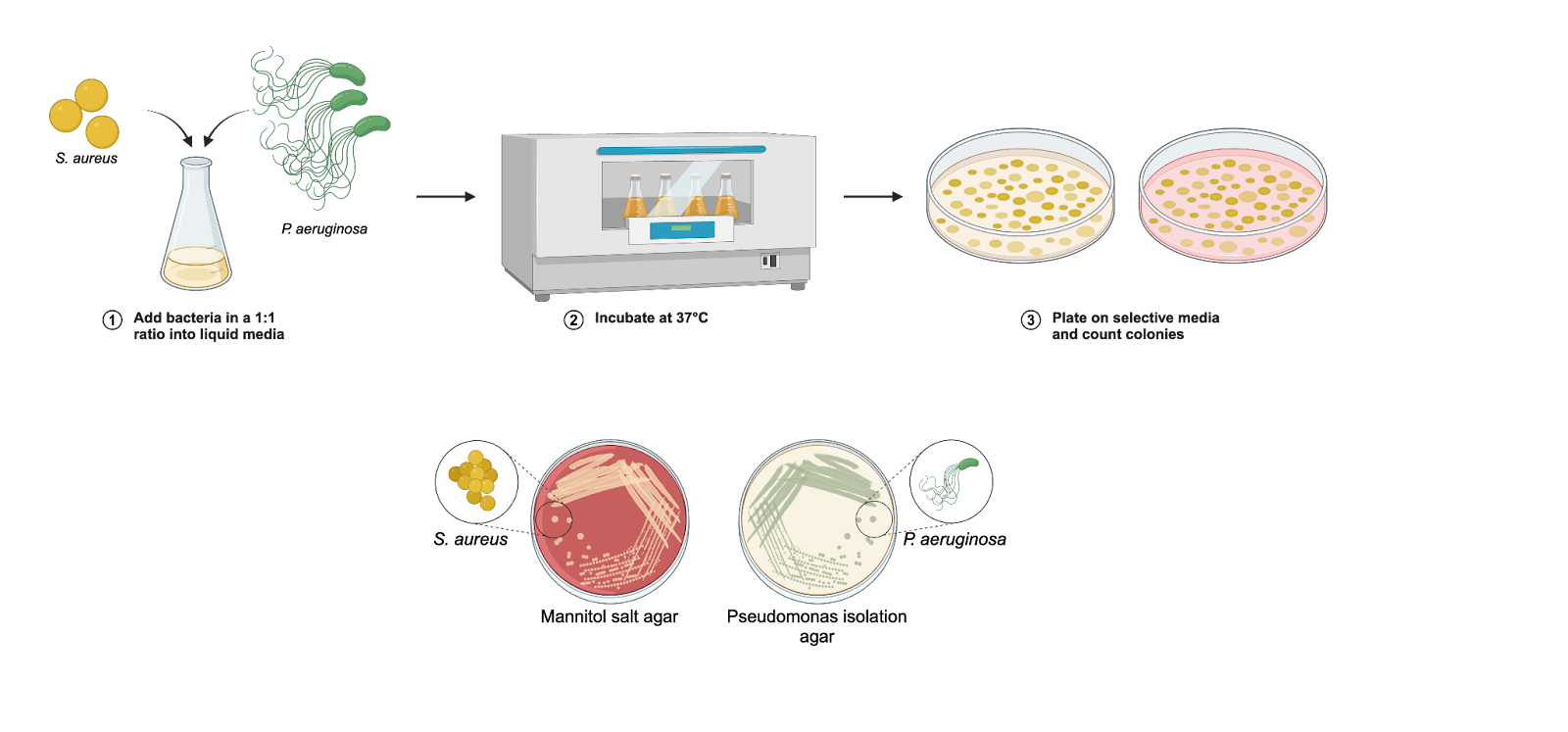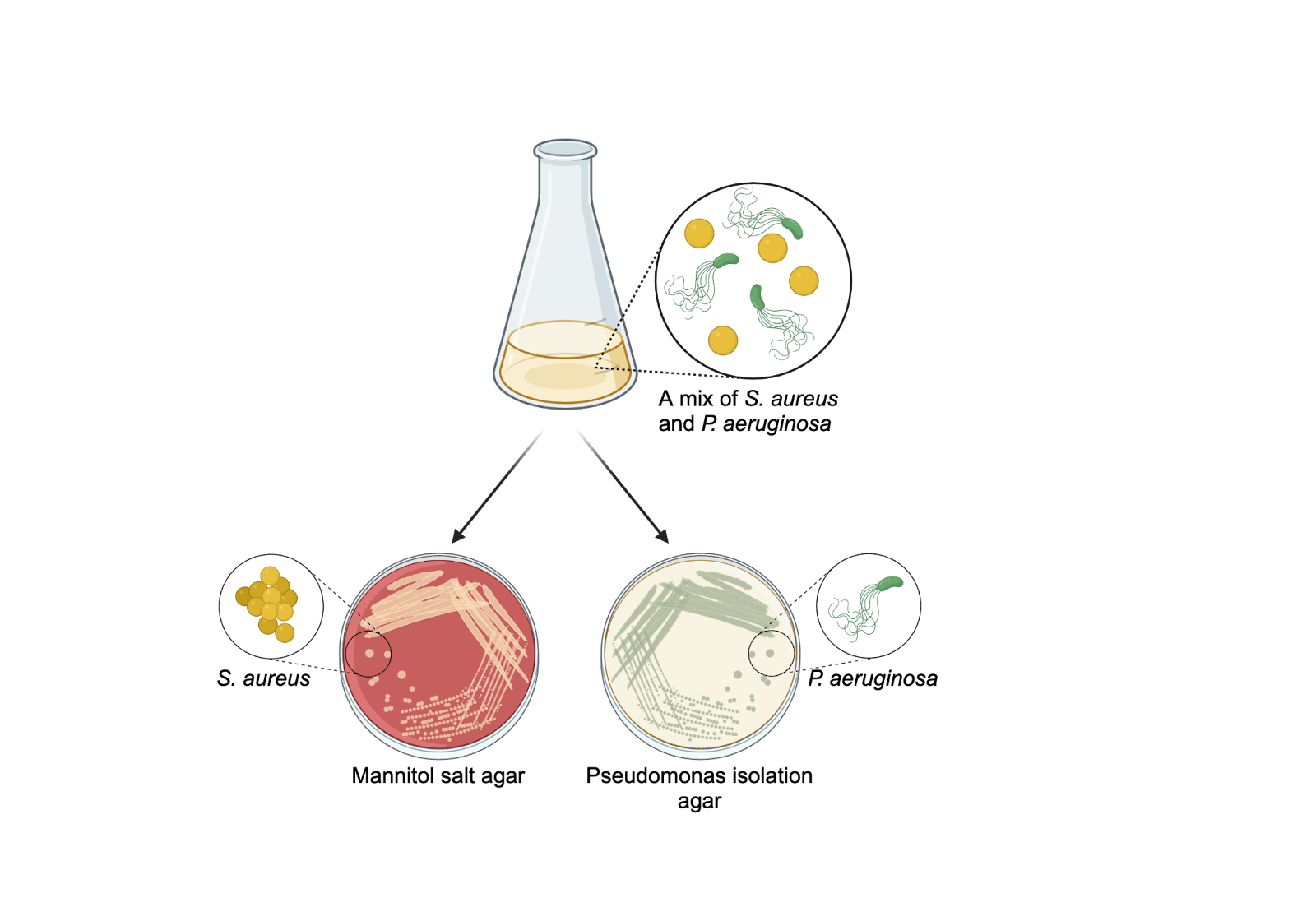by Jamie Liu
Fun Rating: 4/5

Difficulty Rating: 2/5

What is the general purpose?
In nature, various species of bacteria live together. With a lot of species of bacteria, we have a general understanding of how they work and behave on their own. Co-culture assays are used to assess the relationship between two or more bacteria within the same environment. By conducting co-culture assays, we can gain a better understanding as to how bacteria is behaving with each other in nature.
Why do we use it?
While research on individual species of bacteria is important to understanding how they work and how they can be treated, studying microbial interactions (how multiple species interact) is also important because microorganisms can impact one another! By conducting co-culture experiments, we can learn about how bacteria communicate with one another, how they share resources and ultimately influence each other’s growth and survival. Learning about microbial interactions can lead to the development of treatments against harmful bacteria or a better understanding of our microbiomes.
How does it work?
You want to study how the bacterial species Staphylococcus aureus and Pseudomonas aeruginosa live together. Both species can be commonly found in infected wounds and the airways of cystic fibrosis patients. Does one bacteria outlive the other? Can they both survive in the same environment? To answer these questions, you decide to do a co-culture experiment (Figure 1).

Figure 1. Co-culture experiments are used to assess microbial interactions. (1) Bacteria are added to a flask with liquid media in a 1:1 ratio. (2) The flask with bacteria is incubated at 37°C for 24 hours. (3) Bacteria are plated on selective media to determine how much of each is present at the end of the assay. Image created with BioRender.
Both species of bacteria are added to a flask with nutrient-rich media in a 1:1 dilution. We start with a 1:1 ratio to ensure that both species are present in equal amounts and that one does not have an advantage or disadvantage over the other.
In order to determine the amount of bacteria we have, we can take some of our sample, dilute, and spread it on an agar plate. Cultures of bacteria are very dense, meaning there are millions if not billions of bacteria that can grow in small volumes of media. In order to know how much bacteria we have in our sample, we dilute it until we get countable numbers of bacteria, then we can spread that dilution onto our agar plates. The bacteria grow into colonies on the nutrient-rich agar, which can then be counted. Based on the number of dilutions we did, we can back-calculate how much bacteria we have in our sample. However, a lot of bacterial species look the same on an agar plate, small round colonies. How can we confidently tell which species is what? We can use selective media! Ingredients in the selective media allow for the isolation of certain species. For example, mannitol salt agar contains a high concentration of salt which S. aureus can survive in, but P. aeruginosa cannot. On the flip side, Pseudomonas isolation agar has the antibiotic irgasan which P. aeruginosa can survive in, but S. aureus cannot (Figure 2). Using these agars can help us separate two (or more) species of bacteria if they’re mixed together!

Figure 2. Selective media is used to separate different types of bacteria. Mannitol salt agar isolates S. aureus and Pseudomonas isolation agar isolates P. aeruginosa. Image created with BioRender.
Once the bacteria are combined, the flasks are incubated at 37°C for 24 hours. After, the flasks are taken out of the incubator and our sample is diluted and spread on the selective media to determine how much of each species we have. We can then calculate the ratio of S. aureus and P. aeruginosa we have at the end of the experiment and determine if one or both survived.
Co-culture assays can be modified to study a variety of things, such as how different nutrients, drugs, and genes affect bacterial survival. Different species of bacteria require and use different nutrients and byproducts of one species metabolism may affect the it’s cohabitants. Understanding how mixed populations of bacteria impact each other can give us insight into how bacteria work together or against each other. Additionally, it has been shown that co-cultures of bacteria can impact antibiotic susceptibility (how effective antibiotics are against bacteria). Some species of bacteria can protect other species of bacteria against antibiotics. On the other hand, some species of bacteria can make other species more susceptible to antibiotic treatment. This can give us insight as to why antibiotics don’t always work against severe infections or how well antibiotics work.
Co-culture assays can be used to study how different genes affect bacterial survival. If we do not know a function of a gene, we can remove it from a bacteria, making the bacteria a “mutant.” In order to determine if it is important for survival, we can grow the mutant bacteria that are lacking the gene of interest with the original strain of bacteria that has the gene of interest (called wildtype). We can then assess if the mutant bacteria survives just as well or worse than the wildtype bacteria and determine if the gene of interest is important for growth and survival.
Different fields actually use bacterial co-cultures to help us make things. Studying co-cultures of bacteria has led to the application of mixed bacterial populations for drug discovery and chemical and fermented food (like yogurt and cheese) production!
